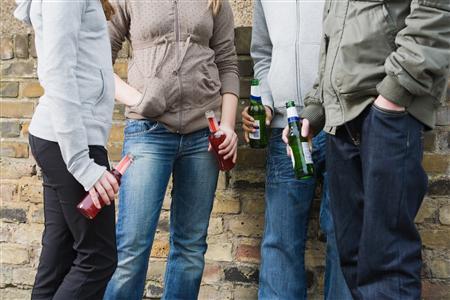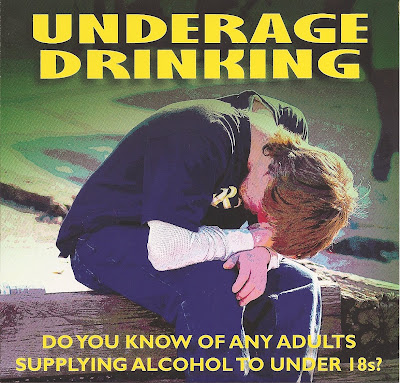Mixing caffeine, alcohol common for underage drinkers
College-age drinkers who mix caffeine and alcohol are more likely to make risky decisions and require medical care, research has shown. A new study suggests younger drinkers often combine caffeine and alcohol as well.
“Although there have been several articles about alcohol and caffeine use among college students, little was known about this phenomenon among younger adolescents,” Dr. Michael Siegel told Reuters Health in an email.
He worked on the study at the Boston University School of Public Health.
Siegel and his colleagues analyzed information from Internet surveys of 1,031 youths aged 13 to 20 years old who’d had at least one alcoholic drink in the past month.
The surveys asked participants whether they consumed energy drinks that contained alcohol and if they mixed caffeine and alcoholic drinks on their own.
The researchers considered traditional caffeinated alcoholic beverages to be alcohol mixed with soda, coffee and tea. Non-traditional beverages were pre-mixed alcoholic energy drinks and alcohol mixed with energy drinks or shots.
 “Most of the previous studies have focused on the combination of energy drinks and alcohol, but have not studied more traditional combinations such as alcohol and soda,” Siegel said.
“Most of the previous studies have focused on the combination of energy drinks and alcohol, but have not studied more traditional combinations such as alcohol and soda,” Siegel said.
Just over half of the participants reported drinking caffeine and alcohol together in the previous month. Than included 48 percent of 13- to 15-year-old drinkers, 45 percent of 16- to 18-year-olds and 58 percent of 19- and 20-year-olds.
More teens drank traditional caffeinated alcoholic beverages than non-traditional beverages - 46 percent compared to 20 percent.
The researchers found teens who had started drinking between age 11 and 13 were more likely to report recently drinking caffeinated alcoholic beverages than those who started later.
 The findings suggest mixing caffeine and alcohol is more common among underage drinkers and starts at a much earlier age than previously thought, Siegel and his team wrote in the journal Addictive Behaviors.
The findings suggest mixing caffeine and alcohol is more common among underage drinkers and starts at a much earlier age than previously thought, Siegel and his team wrote in the journal Addictive Behaviors.
They found young people who consumed energy drinks and shots mixed with alcohol were several times more likely to binge drink, get in fights and sustain alcohol-related injuries than those who did not.
The same link existed among those who mixed alcohol with soda, coffee and tea, but to a lesser extent.
“This may be due to the fact that energy drinks provide more caffeine than soda or coffee. There appears to be a gradation of effect, with higher amounts of caffeine associated with even higher risks of adverse outcomes,” Siegel said.
“Ultimately what’s probably happening is that kids who are driven to seek out new experiences push the limits in various ways. Energy drinks fit into that,” Aaron White told Reuters Health.
He is with the Division of Epidemiology and Prevention Research at the National Institute on Alcohol Abuse and Alcoholism and was not involved in the new study.
“Energy drinks are a way to be edgy, literally and culturally edgy, and a way to take some chances,” White said.
Mixing alcohol and caffeine can mask some of the feelings of intoxication, making teens think they can drink more.
“Caffeine can make you feel like you’re less intoxicated. It doesn’t reduce your level of intoxication,” White said.
Many products containing caffeine and alcohol such as Four Loko have been taken off the market or reformulated without caffeine, the researchers noted. But that doesn’t seem to be stopping young people from mixing their own.
“We believe that efforts to educate youth about the adverse outcomes associated with the consumption of alcohol and caffeine are warranted,” Siegel said.
“Parents should be aware that underage youth are often adding alcohol to non-alcoholic beverages like soda and energy drinks,” he added.
“While the dangers of pre-mixed beverages containing caffeine and alcohol have received widespread media attention, we found that the main source of (caffeinated alcoholic beverage) use among youth is self-mixing of caffeine and alcohol,” Siegel said. “These results should become a part of health education programs for teens.”
SOURCE: Addictive Behaviors, online October 8, 2013
###
The use of caffeinated alcoholic beverages among underage drinkers: Results of a national survey
The mixing of alcoholic beverages with caffeine has been identified as a public health problem among college students; however, little is known about the consumption of such drinks among younger adolescents. We estimated the prevalence of caffeinated alcoholic beverage (CAB) use among a wide age range of underage drinkers, examined differences in traditional (i.e. self-mixed alcoholic beverages with soda, coffee and tea) and non-traditional CAB use (pre-mixed caffeinated alcoholic beverages or self-mixed alcoholic beverages with energy drinks or energy shots) among underage drinkers by age and other demographic characteristics, and examined differences in hazardous drinking behavior between CAB and non-CAB users.
Results
The overall prevalence of CAB use in the sample of underage drinkers was 52.4% (95% confidence interval [CI], 47.4%–57.4%). CAB prevalence was 48.4% among 13–15 year-old drinkers, 45.3% among 16–18 year-old drinkers, and 58.4% among 19–20 year-old drinkers. After controlling for other variables, we found a continuum of risk with non-traditional CAB use most significantly associated with binge drinking (odds ratio [OR] = 6.3), fighting (OR = 4.4), and alcohol-related injuries (OR = 5.6).
Conclusions
The problem of caffeinated alcoholic beverage use is not restricted to college-aged youth. The prevalence of CAB use among underage drinkers is higher than previously thought and begins in early adolescence. Adolescents who consume CABs, and particularly non-traditional CABs, are at increased risk of adverse outcomes.
Kalé Z. Kponee,
Michael Siegel,
David H. Jernigan